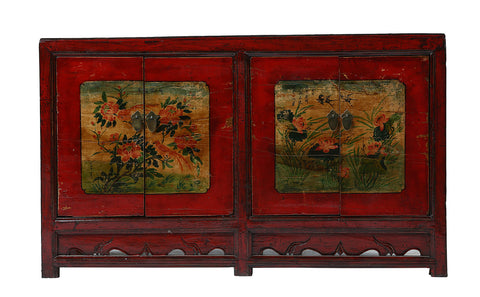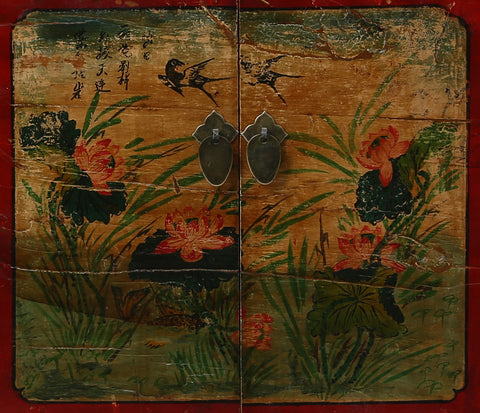October 05, 2016

For our exhibition 'Traditional & Contemporary Decorative Chinese Motifs in the Home for the London Design Festival 2016, we set ourselves the challenge to interpret the hidden meanings of the paintings on two pieces of furniture, the Tiger Cabinet (Gansu, China, ca. 1920), pictured below

and the Spring Blessings Cabinet (Gansu, China, 1974), pictured below.

The visual art of China is intricately connected to the Chinese language. The Chinese language possesses far more characters than sounds. Consequently, many words sound similar or the same. Based on this abundance of homophones, a tradition has developed, in which Chinese decorative motifs have hidden auspicious meanings, in addition to the direct symbolic meanings that derive from their own properties.
An example is bamboo (zhú 竹). ‘Bamboo is … said to be symbolic of filial piety because it grows in thickets or groves close to its “parents”.’ (Welch, p.21). In addition, it is a homophone of (zhù 祝), to wish or to congratulate. Therefore, whenever bamboo is included in a painting, its ‘hidden’ meaning is to carry a wish, or a blessing.
The combination of motifs can make up nuanced messages or blessings. Many of the decorative paintings on Chinese Vintage furniture carry well-known blessings for domestic harmony, longevity, fertility, wealth and honour.
A lot of information is available online about the symbolic meaning of individual motifs, but to get to the hidden meaning, based on rebuses and homophones, we relied on two excellent books:
Chinese Art – A Guide to Motifs and Visual Imagery (Patricia Bjaaland Welch, 2008)
Hidden Meanings In Chinese Art (Terese Tse Bartholomew, 2006)
Below we share with you what we could find out, first for the Tiger Cabinet, and then for the Spring Blessings Cabinet.
The Tiger Cabinet (Gansu, China, ca. 1920)
Left Drawer:
Decorative Motifs:
Mountain Flower (shān huā 山花) wild flowers that grow on mountains
Characters:
山花烂慢 (shān huā làn màn) ‘mountain flowers blossoming in
splendor’
 L
L
Right Drawer:
Decorative Motifs:
Lotus (莲花 lion huā) or (荷花 hé huā). Lotus symbolises continuity and harmony in a domestic context, and purity and detachment from worldly cares in a philosophical context.
Characters:
芙蕖青莲 (fú qú qīng lián) ‘lotus and blue lotus’. This phrase references the symbolism of coloured lotuses: ‘Red Lotus … represents the original nature of the heart and symbolises love, compassion and passion. The blue lotus, shown partially open, symbolises wisdom, knowledge and the victory of the spirit over the senses’ (Welch, p. 194-5).

The Doors
Decorative Motifs:
Mountain (shān 山). Mountains are the places closest to the gods and because of their expanse and height convey the meaning of limitlessness. Shān (山) is also a homophone of shine (善) good, friendly, kind and perfect. ‘A “shine person” is the Chinese expression for “Philantropist”.’ (Welch, p.252)
Pine (sōng 松). Pine is a symbol of longevity and endurance. It has no homophone.
Bamboo (zhú 竹) Bamboo ’stands for vitality and longevity. It bends in the storm but does not break; thus it symbolises humility, fidelity, and integrity (Bartholomew, 8.2). It is a homophone of zhù (祝) ‘to wish or to congratulate’. The combination of bamboo and pine carries the hidden meaning ‘May the family unite and flourish’ (zhúbāo sōngmào 竹苞松茂). This motif is often used to congratulate a family moving into a new residence.’ (Bartholomew, 3.1.1).
Tiger (hŭ 虎). The tiger is a traditional symbol of strength and protection, and a homophone of (hù 护) ‘to protect, guard, shield’ and (hù 祜) ‘blessing’ (Welch, p. 51). In the Qing dynasty, it was the symbol of a military official of the third rank. The depiction of a tiger in a pine grove stands for ‘courage coupled with endurance’ (Welch, p.109).
Characters:
气雄千里,威仪震万 (qì xióng qiān lĭ, wēi yí zhèn won) ‘powerful energy, reaching one thousand lĭ, mighty appearance felt by ten thousands’ (1 lĭ is approx. 500m)

Our Interpretation
The cabinet is decorated with auspicious symbols for the unity of a family and the protection of the household. It may have been made for a person who has just moved into a new residence. The decoration carries a pronounced wish for that person to gain honour and influence through courage and perseverance, possibly in a military position. The presence of the mountain and the bamboo grove add a connotation of moral integrity.

The Spring Blessings Cabinet (Gansu, China, April 1974)
Left Door
Decorative Motifs:
Peonies (fùguì huā 富贵花). The peony is closely associated with royalty because it was grown in the imperial gardens of the Sui and Tang dynasties. It is called fugue huā, the flower of wealth and honour (honour stands for high social status or official rank).
Ribbon-tailed birds (shòudàiniăo 绶带鸟). Ribbon-tailed birds symbolise longevity ‘because the ribbon (shòu 绶) is a pun for longevity (shòu 寿).’ (Bartholomew, 7.51).
Two ribbon-tailed birds = double longevity (Bartholomew, 7.51.1)
Characters:
七四年四月 (qī sì nián sì yuè) ‘April 1974’
幸福花开 (xìn fú huā kāi) ‘May happiness blossom like a flower’

Right Door
Decorative motifs:
Swallow (yàn 燕). Swallows are a symbol for spring. Swallow (yàn 燕) is a homophone of yàn (宴) ‘banquet’.
Carp (lĭyú 鲤鱼). The carp is a pun for (lìyù 利餘) ‘enormous wealth’ (Bartholomew, 6.11).
Lotus (héhuā 荷花) or (liánhuā 莲花). héhuā is a pun for harmony, harmonious marriage. Liana symbolises continuity and can be combined with fish to represent liánnián yuyú (连年有余), ‘abundance year after year’ (Bartholomew, p.19).
Characters:
映日荷花别样红,接天连叶无穷碧 (yang rì hé huā bié yàng hang, jiē tiē lion yin wú qióng bì) – references a poem about the famous West Lake in June, praising the beauty of the flowering lotus in the sunshine.


Overall, we felt the style of the paintings on the Spring Blessings Cabinet matched the cheerful blessings they convey. The serious message, with its emphasis on discipline and moral, contained in the combination of the motifs of the Tiger Cabinet, however, did surprise and intrigue us.
To share our fascination with Chinese decorative motifs, we have hosted a creative workshop during the London Design Festival and we are going to repeat it on Sunday, 16th October (11am - 1pm) at the shop. To find out more about the upcoming workshop and to book a ticket, please click here.
